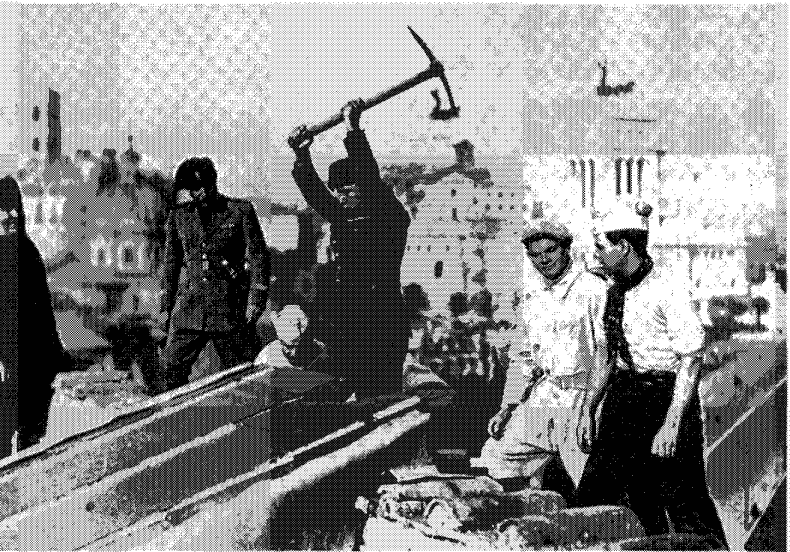Construction of Ram Mandir in Ayodhya in the place of the demolished Babri Masjid was started. Next, Krishna Janmabhoomi, Kashi Vishwanath temple, etc. The Hindutva nationalists argue Shahi Idgah Mosque was built on Krishna Janmabhoomi ruins and Gyanvapi Mosque was built on the Kashi Vishwanath temple ruins. The disputes around these sites are already going on. Hindutva fascism and politics around archaeological sites like Ayodhya were copied from disastrous Mussolini’s fascism and Hitler’s Nazism.The European fascist nationalists fooled their citizens with fraudulent archaeological excavations, forgeries, distortion, misinformation, hatred, & violence. Their actions resulted in the deaths of millions of people and the collapse of economies. In the same way, Hindutva nationalists are now deceiving the Hindus and destroying the country.
This post is not just about politics. I discussed how European scholars and academicians like archaeologists and historians and other influential people with biased thinking and national pride share misinformation, distort history and serve the interests of fascist politicians, and the disastrous consequences of fascist nationalism.
Fascist nationalism resulted in authoritarian governments, forcible suppression of opposition, divisions among people, hatred, violence, no freedom of speech, suppression of dissenting voices, and promotion of pseudoscience, and superstitions. The disastrous Italian fascism and Nazism in Europe didn’t evolve in a year or two. It evolved over a period of several decades and took a severe form by World War II. Similarly Hindutva fascism is now developing strongly.
In her book, In the Shadow of the Swastika (2011), Marzia Casolari, author and associate professor of Asian history at the University of Turin, Italy, said, 1
‘’Today, when the BJP is in power and the Sangh Parivar is as strong as ever before in Indian history, it is possible to confirm Nehru’s definition of Hindu nationalism (Hindutva) as “an Indian version of Fascism”. But we can go further and define today’s Sangh Parivar as an Indian version of Nazism. The heavy discriminations, persecution, violence and segregation imposed by the BJP government and by the Hindutva forces on Indian Muslims recollect the theories, methods and practices adopted by fascist and nazi dictators and their followers.’’
Marzia Casolari in her book 'In the Shadow of the Swastika" Tweet
A new version of the same book was released in 2020.
Origins of political nationalism
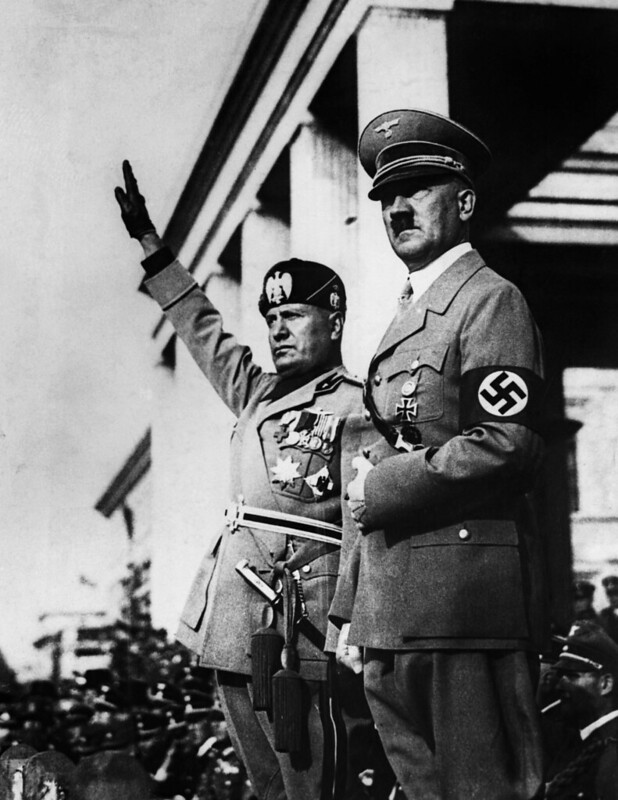
Image: Italian dictator Mussolini (left) and German dictator Adolf Hitler (right) in Munich, 1937.
Image by Tullio Saba.
Political nationalism appeared at the end of the eighteenth century, at the time of the French Revolution (1789–1799). Any homogeneous community that shared a common territory, ethnicity, religion, language, or culture became the criteria to define a nation and form a political self-government. Ethnicity and language became key criteria. 2
However, proving the existence of a nation requires a past that needs to be described. Historical documents, literature, and archaeology were used to describe the past. History was transformed from an artistic and literary pursuit into a scientific discipline only at the end of the 18th century and the beginning of the 19th century. Archaeology became a scientific discipline only in the 19th century, and it played an important role in building nationalism.
Communities which are insecure or faced attacks from others often tend to have more nationalistic feelings. Some communities utilized nationalism to form as nations. But the examples of German and Italian fascist nationalism were two extreme cases of using archaeology and other fields to justify oppression of their own citizens, territorial invasion and racial extermination.
France became a nation-state (probably the first) after the French revolution (1799). Some scholars consider the establishment of the English Commonwealth in 1649 as the earliest instance of nation-state creation. Italy became a nation-state in 1861 and Germany became a nation-state (German Reich) in 1871.
Fascism gained popularity in the early 20th-century in Europe. The first fascist movements emerged in Italy during World War I and spread to other European countries, most notably Germany.
Italian fascism and archaeology
Italian fascism is a cultural nationalism under its dictator Benito Mussolini (1922-45). The first three among the following four characteristics were considered as a criteria to define the Italian nation.
1. Identifying Italy’s past with the Roman Empire (27 BC–AD 330) of Rome and other cities.They often achieved this with fraudulent archaeological excavations, and forgeries of the inscriptions to suit the sources like historical records or literature. Sometimes, the sources were created.
Hindutva nationalists misrepresent India’s past as a mere Vedic culture and the Vedic Aryans as the people of the Harappan civilization.
2. Territorial invasion to create Italian colonies. They used archaeological (fraudulent) findings to justify this.
3. Culture superiority, where north Italy’s culture was considered civilized in prehistoric times and north Italy civilized south Italy. The fascists in northern Italy wanted unification of both regions. Cultures of minorities and of people who questioned the ideas of fascists were destroyed.
4. Civilians who opposed fascist policies were persecuted and killed.
Mussolini, who was a journalist, was good at utilizing every media to promote fascist ideas effectively. Thousands of Italian civilians died and lakhs of people died in concentration camps, colonial wars, World War 2 and famines caused by these wars. The total death toll caused by Mussolini’s fascist rule was estimated to be more than 15 lakhs.
Hitler's Nazism and archaeology
Anthropologists, archaeologists, ethnologists, prehistorians, and other intellectuals with biased views and German national pride influenced the opinions of the Germans, including German dictator Adolf Hitler (1889–1945) and played a key role in building German nationalism.
Hitler’s Nazism is a ethnic/racial supremacist nationalism. The first three among the following four characteristics were considered as a criteria to define the German nation.
1. Identifying Germany’s past with prehistoric Germania, which was north-central Europe adjacent to the Roman Empire. Germania was saved from Roman conquest by Arminius (17 BC–21 AD), chieftain of the Germanic Cherusci tribe. He became a symbol of the idea of national unification.
Ancient mythologies like Edda and Nibelungenlied and the literature of the ancient Roman historian Tacitus were used as authoritative sources of German prehistory.
Hindutva politics revolves around epics like the Ramayana and Mahabharata, which don’t have any solid historical evidence.
2. Racism and Antisemitism (hostility to, prejudice towards, or discrimination against Jews). Hitler believed in a pseudoscientific racial hierarchy where Aryans occupied the highest place and Jews the lowest place. He believed Aryans were a pure race and ‘founders of culture’ and Jews were the ‘destroyers of the culture’.
Hitler made Jews scapegoats. He believed Jews were responsible for Germany’s loss in World War I, the economic decline of Germany, and communism, and they wanted to dominate the world. He compared Jews with germs and said they needed to be exterminated. None of his prejudiced beliefs are true. Around 1 lakh German and Austrian Jews had fought for their nations in World War I.
Muslims are becoming scapegoats in Hindutva.
3. Justifying territorial expansion to the north, west, and south of Germany was easy as Germanic languages were spoken in these regions. To justify the expansion in the east of Germany, where Slavic languages were spoken, Nazis pushed the history of ancient Germans to 9,000 B.C. Similarly, Hindutva nationalists are propagating that the Aryans were present in the Indian subcontinent even before the Harappan civilization without proper evidence.
4. Civilians who opposed Nazi government policies were persecuted and killed.
In all the above-mentioned first three cases, Nazi leaders used fraudulent archaeological and other findings to support their nationalistic ideas. For example, the pseudo-scientific organization The Ahnenerbe was established to promote the racial doctrines adopted by Hitler and the Nazi Party. It was composed of scholars and scientists from a broad range of academic disciplines, who promoted the idea that Germans descended from the Aryan race, who were racially superior to other races.
Hindutva fascism
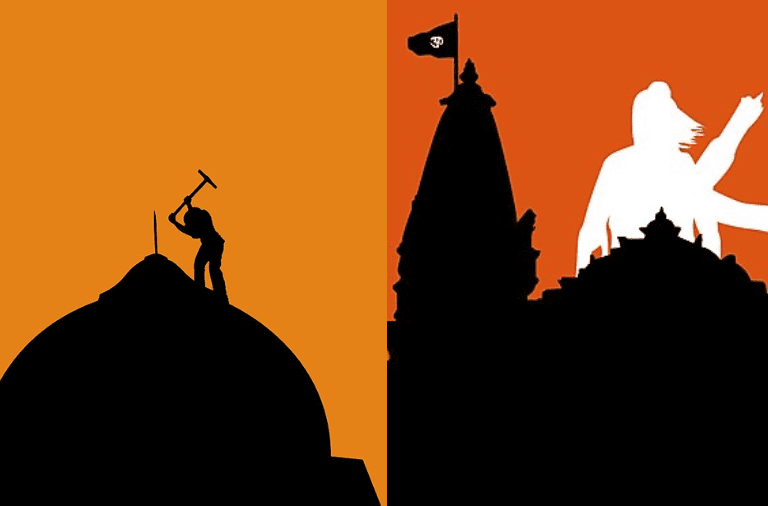
Hindutva fascism is both cultural and ethnic nationalism. The views of the Hindutva ideologues are historically and scientifically incorrect. I discussed this in my earlier blog post.
Hindutva fascism has strong and weak characteristics. The following are its strong characteristics:
1. Hindutva is a Hindu supremacist ideology, which aims to build Hindu Rashtra (nation). Only Hindus are considered citizens and non-Hindus, especially Muslims, should be subordinated to Hindus. Hindus, Sikhs, Buddhists and Jains are considered as Hindus.
2. Heavy discrimination, persecution, and violence against Muslims. Muslims are the main victims, but Christians also the victims. The key purpose of hate propaganda and violence against Muslims and Christians was to unite Hindu votes.
3. Cultural superiority and appropriation: Considering the Vedic culture developed by Indo-Aryans, who migrated to the Indian subcontinent after 2,000 B.C., as the only and superior Indian culture despite the existence of advanced Indus Valley or Harappan culture (3,300 BC–1,300 BC) before the Vedic culture.
Hindutva nationalists propagate Vedic culture as being the most superior culture in the world. This view is often expressed by promoting India (Vedic India) as Vishva Guru (the world’s teacher). They also propagate Vedic Aryans made many scientific (not true) inventions a long time ago and western copied them.
They try to impose the Hindi language, which was descended from the Sanskrit language used by Indo-Aryans, on non-Hindi-speaking people. They also force their food habits on others. One example is the ban on serving eggs in midday meals served in government schools in BJP-ruled states.
There are weak characteristics (for now) of Hindutva like ‘Akhand Bharat’ (unbroken India). The Hindutva definition of ‘Akhand Bhrat’ was based on the Hindu epic Mahabharata, which referred to India as “Bharatvarsh” and included parts of many south Asian countries. It is a Hindu majoritarian imperialistic idea.
Hindutva leaders have been promoting this idea since the partition of India. Hindutva leaders often talk about it. When Pralhad Joshi, Union Minister in the BJP government, shared a map of ‘Akhand Bharat’ on Twitter, it caused an uproar from the neighboring countries of Nepal, Pakistan, and Bangladesh.
Hindutva nationalists inspired by Italian fascism and Nazism
RSS and Italian fascist cultural organizations
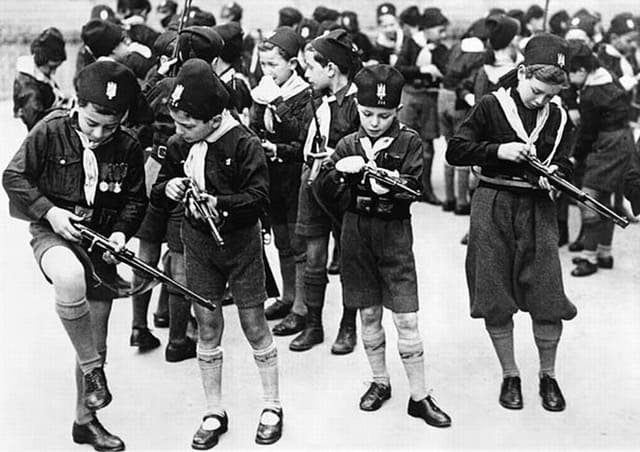
Image: Italian children being trained to be militants at the Italian Ballila fascist organization
The paramilitary structure of RSS was inspired by Italian fascist youth organizations.
B.S. Moonje was a leader of Akhil Bharat Hindu Mahasabha (ABHM), which is a Hindu nationalist political party founded in 1915. He visited Italy in 1931, met Mussolini, and was greatly impressed by the Italian fascist paramilitary organizations like Opera Nazionale Balilla (ONB). In 1926, the Ministry of National Education started ONB as a cultural youth organization, which indoctrinated the youth as “the fascists of tomorrow.”
Moonje wanted to build a Hindu military organization similar to ONB. He mentioned in his diary, 3
“The Balilla institutions and the conception of the whole organization have appealed to me most, though there is still no discipline and organization of high order. The idea of fascism vividly brings out the conception of unity amongst people. India and particularly Hindu India need some such institution for the military regeneration of the Hindus.”
B.S. Moonje, leader of Akhil Bharat Hindu Mahasabha Tweet
In her book, ‘In the Shadow of the Swastika’ Marzia Casolari said, 4
“The RSS method of recruitment was practically identical to that of the Balilla youth organization in Italy. Shaka members, for instance, were grouped according to their age (6–7 to 10; 10 to 14; 14 to 28; 28 and older).”
Marzia Casolari in her book 'In the Shadow of the Swastika" Tweet
Hedgewar founded RSS in 1925. He was greatly influenced by his political mentor Moonje and the Hindutva ideology of Damodar Svarkar, who took charge as All India President of ABHM from Moonje in 1927. Close relationships existed between RSS and ABHM, until Nathuram Gadse, an ABHM activist, assassinated M.K Gandhi in 1948.
Nazism against Jews and Hindutva against Muslims

Image: A mass grave of Jews at Bergen-Belsen after the Nazi concentration camp’s liberation, April 1945
Like Nazi nationalists, Hindutva ideologues and the present Hindutva leaders too believed in the superiority of the Aryan race. Marzia Casolari said, 5
“The Nazis’ glorification of the “Aryan” race is erroneously interpreted by militant Hindus as a vindication of their own doctrine of race and caste. The adoption of the old Hindu symbol of the Swastika by the Nazis is regarded by them as a manifestation of the proximity of Hitler’s philosophy to Hinduism.”
Marzia Casolari in her book 'In the Shadow of the Swastika" Tweet
Nazi nationalists considered Jews an inferior race and compared them with germs, which needed to be eradicated. Hindutva nationalists propagate Muslims as invaders and traitors. They run hate propaganda and carry out violence against Muslims. This kind of behavior by present nationalists can be easily understood by what Hindutva ideologues preached a few decades ago.
Gowalkar said, 6
“In one word, they [Muslims] must cease to be foreigners or may stay in the country wholly subordinated to the Hindu nation, claiming nothing, deserving no privileges, far less any preferential treatment, not even citizen’s rights.”
M. S. Golwalkar, second Sarsanghchalak (chief) of the RSS Tweet
Lakhs of Muslims died in the Indian independence struggle. The irony is that the RSS never participated in the Indian independence movement. When the freedom fighters were arrested during the Quit India movement, Hindu Mahasabha collaborated with the British government and formed a coalition government with the Muslim League in Bengal, Sind, and the North-West Frontier Province (NWFP).
The Hindutva ideologues appreciated Mussolini and Hitler, whose fascism caused lakhs of deaths of Jews, Muslims, and others in holocausts, crores of deaths in World War II, and destruction of the economies of many countries.
In 1938, the second Sarsanghchalak (chief) of the RSS, M.S. Golwalkar, appreciated Hitler’s persecution and genocide of Jews and said,
“Keep up the purity of the race (Aryan) and its culture.”
M. S. Golwalkar, second Sarsanghchalak (chief) of the RSS Tweet
“Germany has every right to resort to Nazism and Italy to fascism.”
Damodar Savarkar, the key Hindutva ideologue Tweet
Nazi eugenics and the RSS’s ‘Uttam Santati’
The concepts like biological Aryan race or racial hierarchy are unscientific. But Hindu nationalists still believe in such pseudoscience. Arogya Bharati, a health wing of the RSS, initiated a project called the ‘Garbh Vigyan Sanskar,’ which aims at making ‘Uttam Santati’ or fair and tall humans with higher IQ. The project was initially launched in Gujarat, probably in 2005, and was expanded to the national level by 2015. Dr. Hitesh Jani, the national convenor of the Arogya Bharati, said, “Babies of dark-skinned parents with lesser height can have a fair complexion and grow taller” with this project.
It is pure racial discrimination.
The Uttam Santati project was based on the Nazis’ eugenic project Lebensbron (Fount of Life). The project was based on the pseudoscience of racial hygiene, and Nazis believed that this would increase the birth rate of ‘Aryan’ children. Racial hygiene involves extramarital relationships between persons who were classified as ‘racially pure and healthy’ and giving birth to racially pure children.
You read it right! Don’t underestimate morons.
Hindutva propaganda with archaeological projects and saffron archaeologists
As mentioned earlier, academicians and scholars from different fields like archaeology, anthropology, and ethnology, who have national pride and prejudices, played an important role in building fascism and Nazism.7
The ‘bhagwa’ (saffron) archaeologists in the Archaeological Survey of India (ASI) played a similar role in building Hindutva. Hindutva ideologues copied the politics around archaeological sites from European fascist and nationalist movements, which often involved forgeries, distortion, misinformation, hatred, and violence.
Hindutva nationalists undertake two kinds of archaeological projects to promote Hindutva :
1. Identifying India with locations mentioned in Hindu epics and literature (instead of historical locations) like Ramayana (Ayodhya) and Mahabharata (Hastinapura, Mathura & Kurukshetra). It is similar to how Italian fascists tried to identify Italy with classical Rome and Nazis tried to identify Germany with prehistoric Germania. All of these are not historically correct.
2. Aryanizing Indus Valley or Harappan civilization, which involved projects like ‘Fake horse seal’ project, Indus-Saraswati project, and fraudulent reporting of DNA studies, and other ongoing archaeological projects. I already discussed this in another blog post. The main objective of these projects was to convince Indians that Aryans never migrated to India and Aryans developed Harappan civilization.
Braj Basi Lal, a former Director General (1968 to 1972) of ASI, was known as ‘bhagwa’ (saffron) archaeologist. He worked on the archaeological Mahabharata sites between 1950 and 1952, sites that have connection with Harappan culture like Kalibangan between 1960 and 69 and Ramayana sites like Ayodhya between 1975 and 1980.
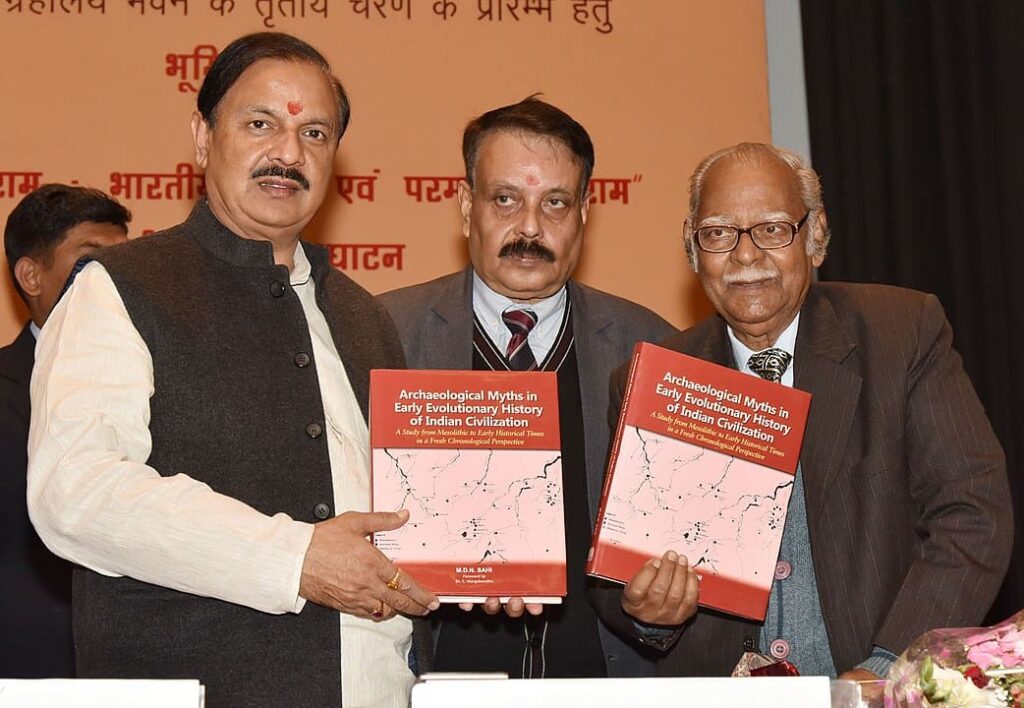
Image: The BJP Minister Dr. Mahesh Sharma releasing the book by the former DG, ASI, Prof. B.B. Lal (far right), in 2017
His false claims include:
1. Linking pre-Buddhist Painted Grey Ware (PGW) found at sites like Hastinapura and Mathura to Mahabharata sites
2. Existence of pillars of a mandir beneath Babri masjid, which led to the demolition of Babri masjid.
3. Suggesting existing Ghaggar-Hakra river as Vedic Saraswati river.
There are other pro-Hindutva archaeologists like B.R Mani and R.S. Bisht, whose students now control ASI excavations.
Archaeologists Supriya Varma and Jaya Menon said, 8
“All senior archaeologists in the ASI have right-wing sympathies. They might not be the RSS pracharaks, but they are openly with the BJP. It is no secret that R.S. Bisht was always close to S.P. Gupta, and B.B. Lal, who, as we all know, are ‘bhagwa’ archaeologists.”
Archaeologists Supriya Varma and Jaya Menon said Tweet
The Hindutva nationalists will continue politics around archaeological sites, and demolish Islamic sites to consolidate Hindu votes.
Footnotes
- Page no. 121, In the Shadow of the Swastika, Marzia Casolari, associate professor of Asian History at the University of Turin, Italy https://iris.unito.it/retrieve/handle/2318/1749839/641763/9780367508265_Casolari.1stP.pdf
- page 169, Nationalism and Archaeology in Europe by Margarita Díaz-Andreu, Timothy Champion
https://www.taylorfrancis.com/books/mono/10.4324/9781315748221/nationalism-archaeology-europe-margarita-di%CC%81az-andreu-timothy-champion - Page no. 42, In the Shadow of the Swastika, Marzia Casolari, associate professor of Asian History at the University of Turin, Italy https://iris.unito.it/retrieve/handle/2318/1749839/641763/9780367508265_Casolari.1stP.pdf
- Page no. 34, In the Shadow of the Swastika, Marzia Casolari, associate professor of Asian History at the University of Turin, Italy https://iris.unito.it/retrieve/handle/2318/1749839/641763/9780367508265_Casolari.1stP.pdf
- Page no. 76, In the Shadow of the Swastika, Marzia Casolari, associate professor of Asian History at the University of Turin, Italy https://iris.unito.it/retrieve/handle/2318/1749839/641763/9780367508265_Casolari.1stP.pdf
- Page no. 91, In the Shadow of the Swastika, Marzia Casolari, associate professor of Asian History at the University of Turin, Italy https://iris.unito.it/retrieve/handle/2318/1749839/641763/9780367508265_Casolari.1stP.pdf
- page 169, Nationalism and Archaeology in Europe by Margarita Díaz-Andreu, Timothy Champion https://www.taylorfrancis.com/books/mono/10.4324/9781315748221/nationalism-archaeology-europe-margarita-di%CC%81az-andreu-timothy-champion
- Was There a Temple under the Babri Masjid? Reading the Archaeological 'Evidence' by Supriya Varma and Jaya Menon: https://www.jstor.org/stable/25764216

